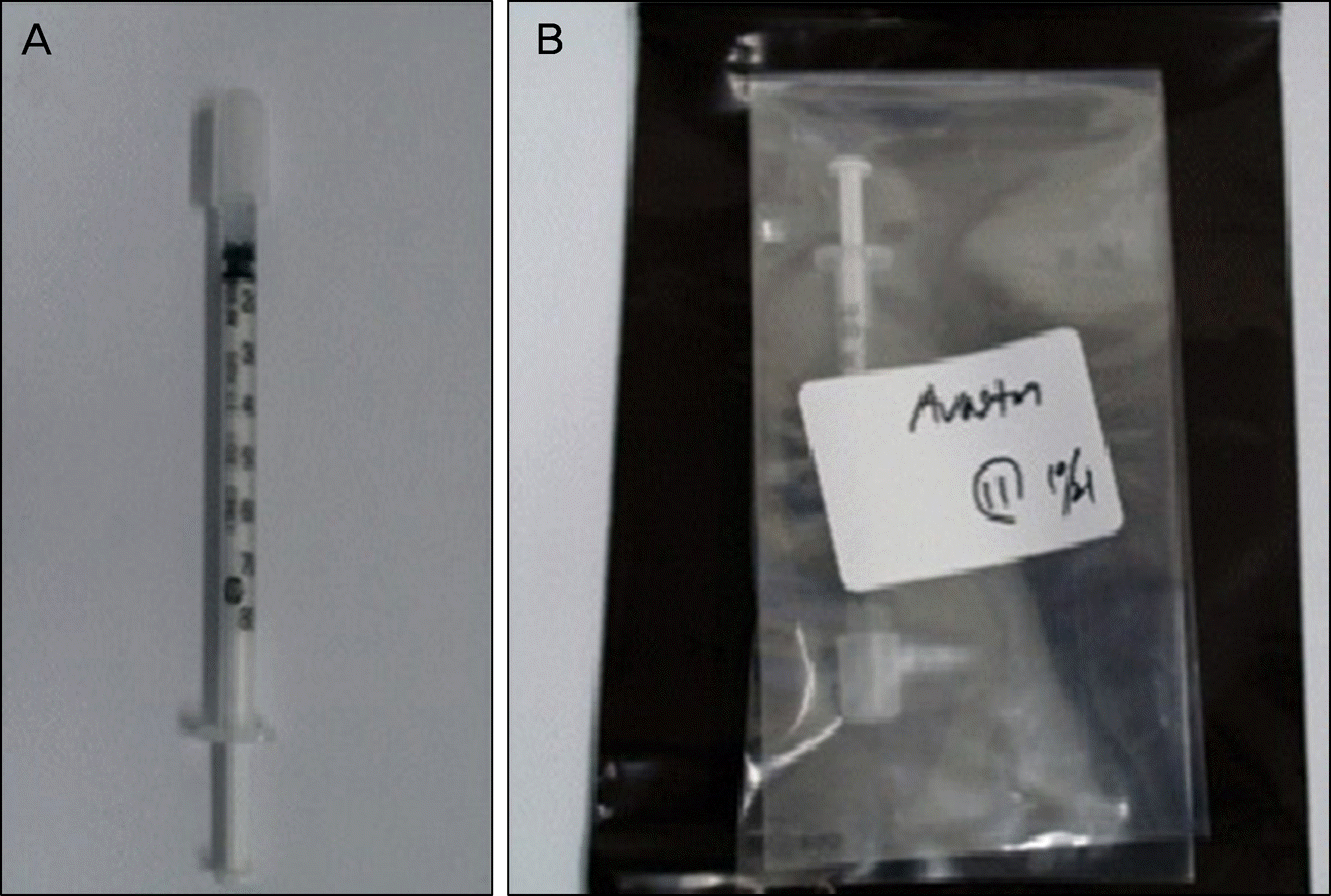Abstract
Purpose
The aim of this study was to evaluate the stability and sterility of bevacizumab (Avastin, Genentech, Inc., San Francisco, CA, USA) after withdrawal into multiple doses from single-use vials.
Methods
Bevacizumab was repeatedly and aseptically drawn from new vials into 1 cc plastic syringes and refrigerated in the dark at 4°C for 0, 3, 6, 12, 28, 38, 46, 52, or 63 weeks or at, −10°C for 0, 3, 6, 12, 38, 46, or 52 weeks. The stability of bevacizumab was assessed by enzyme-linked immunosorbent assay (ELISA) and compared with that of controls (0 weeks). The contents of the fractionated bevacizumab syringes were analyzed for microbial growth.
Results
When we assessed the relative stability of the bevacizumab stored at 4°C, there was no concentration change for up to 12 weeks. However, concentration decreased by less than 2% between 28 weeks and 46 weeks. Samples stored at −10°C were stable up to 52 weeks. All of the fractionated syringes maintained >90% stability compared with controls for up to one year in both the refrigerated group and the frozen group. The microbial study showed no significant positive results for up to 12 weeks. After intravitreal bevacizumab injection, the statuses of all patients improved, with no signs of intraocular infection. We observed no cases of intraocular infection or complications among the patients.
Go to : 
References
1. Hurwitz H, Fehrenbacher L, Novotny W, et al. Bevacizumab plus irinotecan, fluorouracil, and leucovorin for metastatic colorectal cancer. N Engl J Med. 2004; 350:2335–42.

2. Haritoglou C, Kook D, Neubauer A, et al. Intravitreal bevacizumab (Avastin) therapy for persistent diffuse diabetic macular edema. Retina. 2006; 26:999–1005.

3. Jorge R, Costa RA, Calucci D, et al. Intravitreal bevacizumab (Avastin) for persistent new vessels in diabetic retinopathy (IBEPE study). Retina. 2006; 26:1006–13.

4. Iturralde D, Spaide RF, Meyerle CB, et al. Intravitreal bevacizumab (Avastin) treatment of macular edema in central retinal vein occlusion: a short-term study. Retina. 2006; 26:279–84.
5. Yoganathan P, Deramo VA, Lai JC, et al. Visual improvement following intravitreal bevacizumab (Avastin) in exudative age-related macular degeneration. Retina. 2006; 26:994–8.

6. Roche Pharma (Schweiz), G.I.U. Avastin® (bevacizumab), information for patients. 2013.
7. Chen YH, Wu PC, Shiea J, et al. Evaluation of the sterility, stability, and efficacy of bevacizumab stored in multiple-dose vials for 6 months. J Ocul Pharmacol Ther. 2009; 25:65–9.

8. Bakri SJ, Snyder MR, Pulido JS, et al. Six-month stability of bevacizumab (Avastin) binding to vascular endothelial growth factor after withdrawal into a syringe and refrigeration or freezing. Retina. 2006; 26:519–22.

Go to : 
 | Figure 1.(A) The fractionated bevacizumab syringes were sealed with sterile safety caps. (B) For protection from light, the stored bevacizumab syringes were placed in brown plastic bags. |
Table 1.
Mean bevacizumab concentration (optical density, OD), decreasing rate bevacizumab concentration for each sample
| Length of storage (weeks) |
Mean bevacizumab concentration (OD, mg/mL) |
Decreasing rate of bevacizumab concentration (OD) (%) |
||
|---|---|---|---|---|
| Stored at 4°C | Stored at −10°C | Stored at 4°C | Stored at −10°C | |
| 0 | 23.5 | 23.5 | 0.0 | 0.0 |
| 3 | 26.4 | 24.6 | 0.0 | 0.0 |
| 6 | 25.3 | 28.1 | 0.0 | 0.0 |
| 12 | 28.9 | 25.6 | 0.0 | 0.0 |
| 28 | 23.1 | * | 1.7 | * |
| 38 | 23.2 | 24.3 | 1.3 | 0.0 |
| 46 | 23.1 | 24.9 | 1.7 | 0.0 |
| 52 | 22.7 | 23.7 | 3.4 | 0.0 |
| 63 | 22.1 | * | 5.6 | * |




 PDF
PDF ePub
ePub Citation
Citation Print
Print


 XML Download
XML Download